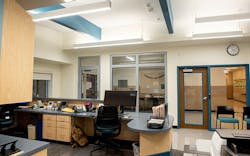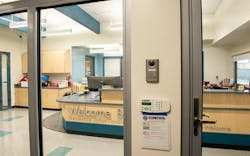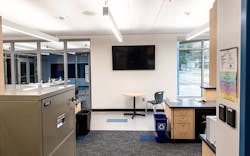Time Barriers: Layering Security Systems for Safe School Design
The Partner Alliance for Safer Schools (PASS) K–12 guidelines recommends a multilayered approach to safe school design. This approach improves the overall effectiveness of a full security plan by providing multiple time barriers to delay violent intruders and creating redundancies should an aspect of one layer fail for any reason.
In addition to creating layers of security from the property line to deep within a school, it is important to consider how different safety and security measures can work together in a single layer. For instance, multifunctional, fire-rated glazing assemblies can offer fire- and forced-entry resistance in a single system to streamline designs. And when these assemblies use components known to be compatible, they sideline risks of one form of protection compromising another.
While planning to enhance school safety and security can involve knowing how to guard against multiple life safety threats, understanding the broader categories of security products can also help specifiers more effectively realize safer school designs. In general, security-rated products, like fire protection systems, can be thought of as either active or passive. But what’s the difference? And which type is better for school safety?
What’s the difference between active and passive protection?
At the most basic level, active protection requires an action to engage it while passive protection guards against threats 24/7 without the need for human intervention. For example, a key-operated lock is active protection, and bullet-resistant glazing is passive.
The line between active and passive protection blurs with measures like automatic locks, alarms, auto-closers on corridor partitioning doors and other automated or partially automated devices. While these types of security measures reduce the level of activity needed to engage the system, they do not completely eliminate it. As with any security product, with active systems, there is a risk of failure, underscoring the importance of a multilayer approach to building security. However, these risks can be mitigated by specifying security devices from manufacturers with a long and proven track record and through faculty training and regular compliance checks—both of which are recommended in the PASS K–12 guidelines.
On the other hand, passive protection is always “engaged,” offering a backup security measure in the event of an active system’s failure or improving the effectiveness of another system. That said, these devices are not without their own limitations. For instance, no matter how impenetrable the materials of a door or window assembly are, if they cannot control access, then intruders can gain entry to a building.
Both types of security devices create time barriers. This begs the question: which type of security should school administrators invest in when enhancing school safety and security?
Which is better for safer school design: active or passive protection?
The answer to this question is that it depends on the school project. Some schools may have active security systems already in place that could be made more effective with passive protection. Others may have several passive systems strategically located throughout the school building. Some schools may have extra budgetary resources to include both types of security measures in a single fiscal year, while others may need to research which measures are most needed in an ongoing investment strategy. Whatever the case may be, it is encouraged that school administrators and the building professionals they may work with consult with security experts and resources to identify which solutions make the most sense for their school’s goals.
That said, when it comes to general strategies for enhancing school safety, it is crucial to remember the multilayered approach—both as it can be applied to the entire campus and to each level of a building security plan. Layering active and passive protection systems together can improve a building’s ability to deter and delay intruders.
As Ken Cook, Director of National School Safety and Advocacy at Allegion, has said, “A building needs all the pieces to work together properly to be secure.” This can include access controls, glazing and school personnel. When each piece is strengthened and properly specified, the effectiveness of building security increases.



